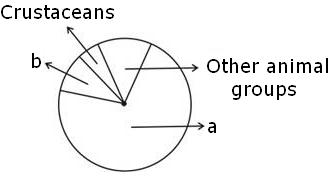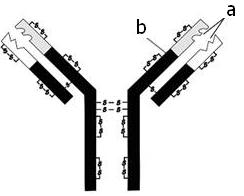Biology:2009:CBSE:[Delhi ]:Set-I
To Access the full content, Please Purchase
-
Q1
Why hnRNA is required to undergo splicing?
Marks:1View AnswerAnswer:
hnRNA undergoes splicing of introns via spliceosomes to produce the final mRNA.
-
Q2
The microscopic pollen grains of the past are obtained as fossils. Mention the characteristic of the pollen grains that makes it happen.
Marks:1View AnswerAnswer:
Pollen grains of the past are obtained as fossils because of the presence of sporopollenin.
-
Q3
How does colostrums provide initial protection against diseases to new born infants ? Give one reason.
Marks:1View AnswerAnswer:
Colostrum is known to contain antibodies called immunoglobulins such as IgA, IgG and IgM which will help in protection against diseases to new born infants.
-
Q4

Name the unlabelled areas ‘a’ and ‘b’ of the pie chart (given above) representing the global biodiversity of invertebrates showing their proportionate number of species of major taxa.
Marks:1View AnswerAnswer:
a) Insects
b) Molluscs -
Q5
Mention the type of evolution that has brought the similarity as seen in potato tuber and sweet potato.
Marks:1View AnswerAnswer:
Convergent evolution
-
Q6
Name of group of organisms and the substrate they act on to produce biogas.
Marks:1View AnswerAnswer:
Methanogens grow anaerobically on cellulosic material to produce biogas.
-
Q7
Mention the pollinating agent of the inflorescence of small dull coloured flowers with well exposed stamens and large feathery stigma. Give any one characteristic of pollen grains produced by such flowers.
Marks:1View AnswerAnswer:
Wind.
Pollen grains are light and non-sticky so that they can be transported by the wind currents. -
Q8
Name the organism commercially used for the production of single cell protein.
Marks:1View AnswerAnswer:
Spirulina
-
Q9
Explain the contribution of Thermos aquaticus in the amplification of a gene of interest.
Marks:2View AnswerAnswer:
Thermostable DNA polymerase is isolated from a bacterium Thermus aquaticus which remain active during the high temperature induced denaturation of double stranded DNA and helps in achievement of repeated amplification.
-
Q10

(i) What does the above diagram illustrate?
(ii) Name the parts labelled ‘a’ and ‘b’.
(iii) Name the type of cells that produce this molecule.Marks:2View AnswerAnswer:
(i) Antibody molecule
(ii) a) Antigen binding site b) Heavy chain
(iii) B-lymphocytes



